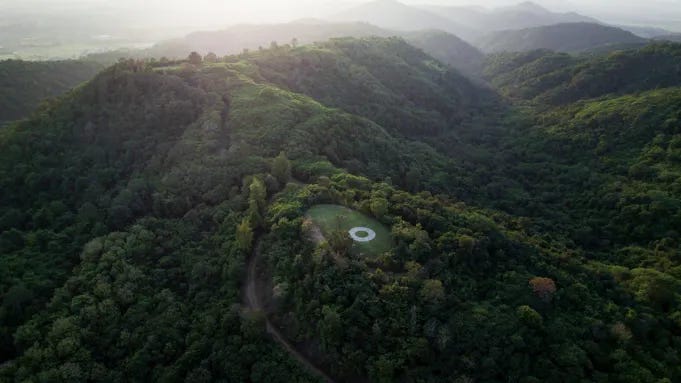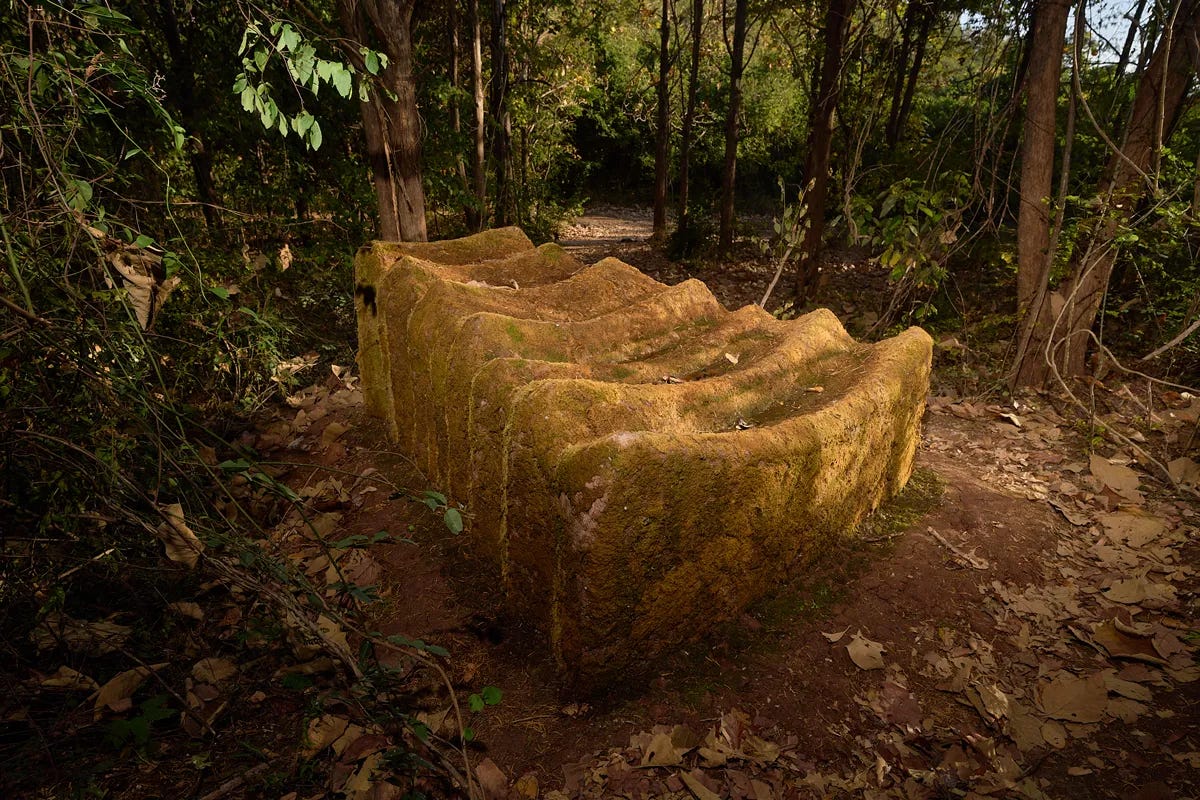
Art has always been a portal—to memory, to meaning, to a heightened awareness of the world around us. It holds the power to transport, to heal, and to reconnect us to something deeper, whether that be nature, history, or the quiet truths of our own existence. This is the foundation of Elysian Intersections, my vision for an artful life—one where beauty is not a luxury but a necessity, where art and well-being are inextricably linked.
Khao Yai Art Forest embodies this ethos in a tangible, immersive way. Conceived by Marisa Chearavanont, a Korean-Thai arts patron, the project is more than an outdoor exhibition space; it is a living, breathing dialogue between art and ecology, a place where creativity and the natural world mirror and restore one another. Set within the lush expanse of Khao Yai National Park, it invites artists to engage directly with the land, creating site-specific works that pulse with the spirit of their surroundings.
She saw the project as a form of reforestation. “I want to heal the land through art,” she explains.

Yet, it wasn’t just the land that needed healing. “In the coming years, all of us will need a kind of healing,” she reflects. “I wanted art to be part of that process.” But rather than adding another private museum or sculpture garden to an already abundant landscape, she envisioned an art forest—a concept she named SilaPaa, a fusion of the Thai words for “art” (Silapa) and “forest” (Paa). Alongside curator Luca Pansera, she invited international artists to create works directly shaped by the land—using its materials, honoring its textures, and responding to its spirit.
The result is a collection of profound, site-specific works: Fog Forest by Japanese artist Fujiko Nakaya, an ephemeral installation of mist; GOD, an enigmatic stone sculpture by Italian artist Francesco Arena; Pilgrimage to Eternity, an earth-based piece incorporating soil and water by Thai artist Ubatsat; and K-BAR, a permanent six-seat pavilion-cum-bar dedicated to German artist Martin Kippenberger, by Danish duo Elmgreen & Dragset.
Chearavanont’s guiding principle to the artists? “Please create art about healing, love, care, and positivity, so that everyone who comes here can absorb that energy and leave with a renewed sense of hope. This is a new paradigm.”
Beyond these commissions, the Art Forest also welcomes works that feel intrinsically tied to its mission. Its current collection includes Maman (1999–2002), Louise Bourgeois’ iconic spider sculpture—a paradox of strength and fragility; Madrid Circle (1988), a stone circle installation by Richard Long; Nouns Slipping into Verbs, a series of wooden sculptures by Richard Nonas; and Two Planets, a video series by Araya Rasdjarmrearnsook depicting Thai villagers reacting to European masterworks in open landscapes.

The most awe-inspiring photograph I have seen from this project captures one of Louise Bourgeois’ most notable works, Maman, against a verdant landscape and a group of monks walking in the foreground. This truly evokes the Elysian spirit: art in service of healing and healing in service of art!
Throughout a career spanning seven decades, Louise Bourgeois crafted a dynamic and evolving body of work that engaged with key avant-garde movements of the 20th century—including Surrealism, Abstract Expressionism, and Post-Minimalism—while remaining deeply personal and uniquely her own. Though her practice encompassed painting, drawing, printmaking, and performance, Bourgeois is best known for her sculptures, which range from intimate to monumental and employ diverse materials such as wood, bronze, latex, marble, and fabric. Her work is both deeply autobiographical—often reflecting childhood wounds shaped by an unfaithful father and a loving yet complicit mother—and profoundly universal, confronting the complexities of human existence.
Standing nearly nine meters tall, Maman is one of Bourgeois’ most ambitious sculptures, part of a series exploring the spider motif that first appeared in her drawings in the 1940s and became central to her work in the 1990s. Created as a tribute to her mother, a weaver, the spider embodies a striking duality—both protector and predator, its silk used to nurture as well as ensnare. These contradictions take on monumental form in Maman, whose towering legs, reminiscent of Gothic arches, create a space that is at once an enclosure and a refuge, sheltering a sac filled with marble eggs. The spider commands both awe and unease, its imposing structure precariously balanced on slender legs, evoking an unsettling yet poignant fragility.
Set within the landscape of Khao Yai Art Forest, Maman takes on an added significance, echoing the necessity of restoring and healing nature. Like the spider, we, too, must reweave our connection with the natural world—our mother, our home.
Khao Yai Art Forest is more than a place—it’s a philosophy. It embodies a vision I deeply believe in: that art is not separate from life, but woven into it. It reminds us that nature is not a passive backdrop but an active collaborator, that beauty can be a form of restoration, and that our connection to art is also a connection to ourselves.
all quotes from https://www.artnews.com/art-news/news/marisa-chearavanont-khao-yai-art-forest-bangkok-kunsthalle-thailand-1234731174/




What a remarkable endeavour!